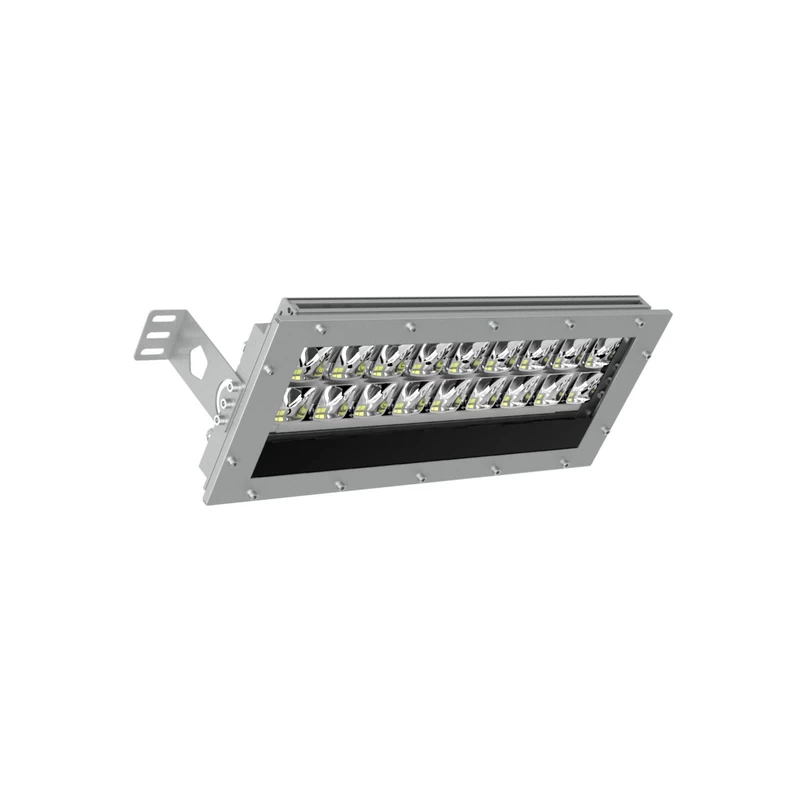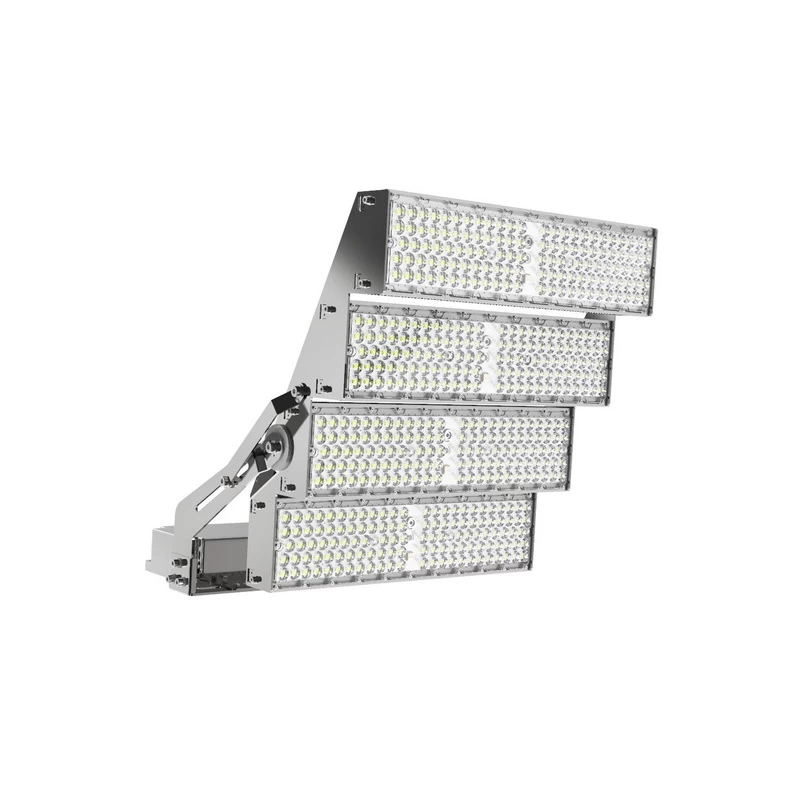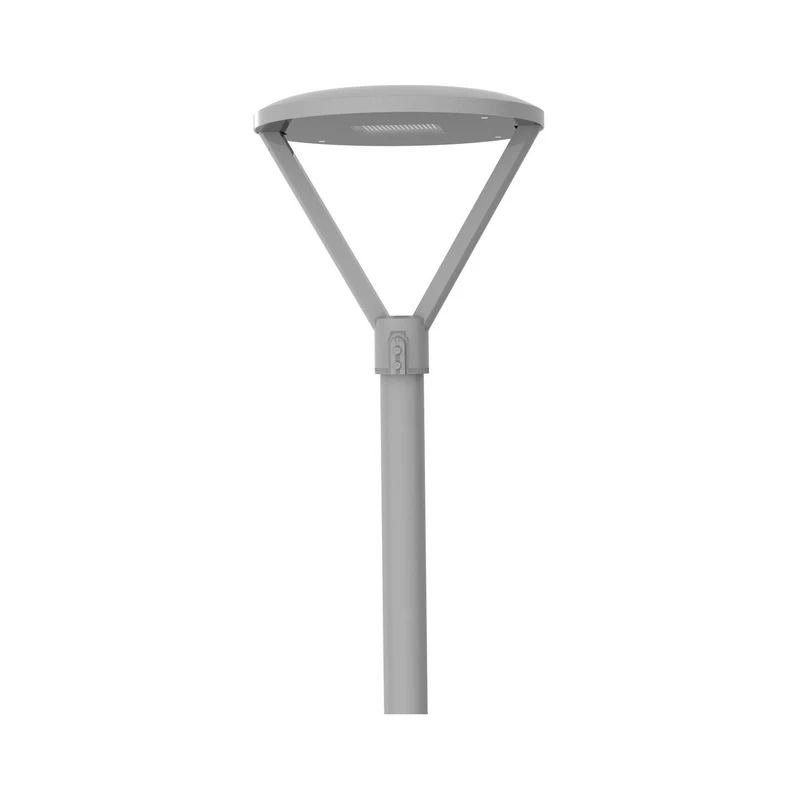Table of Contents
Toggle1. Introduction
LEDs have a wide variety of colors, which are mainly determined by the type and structure of their semiconductor materials. They range from mainstream white to brilliant colors and invisible light. So, what colors do LED lights have? Where are they used? What is color in color temperature?
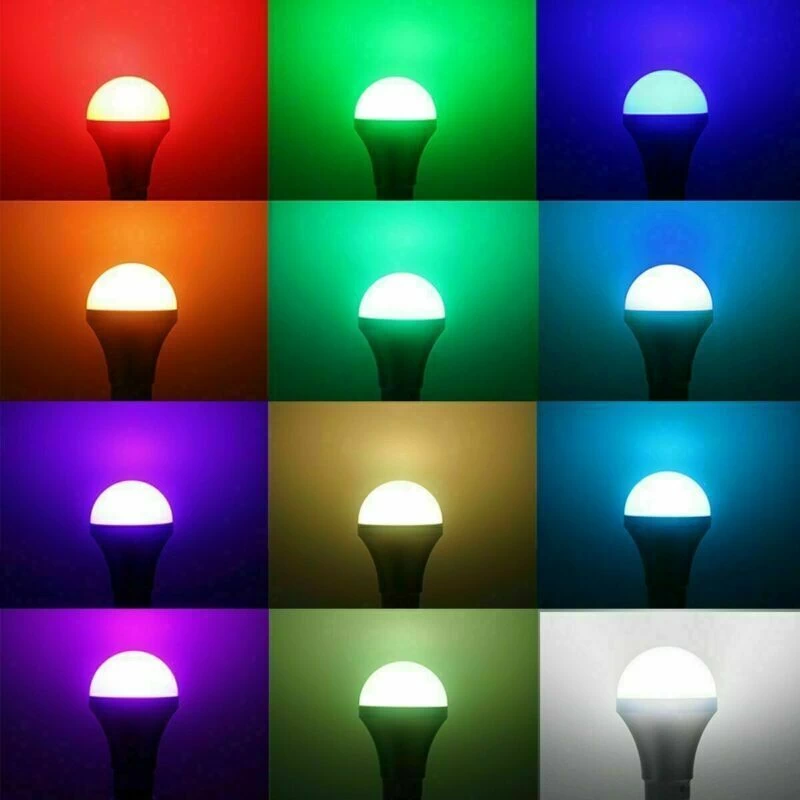
2. LED Color Basics
LED (Light Emitting Diode) is a semiconductor light-emitting device. The color of the light emitted depends on the bandgap of the PN junction material inside it. Different materials emit light of different wavelengths, thus showing different colors.
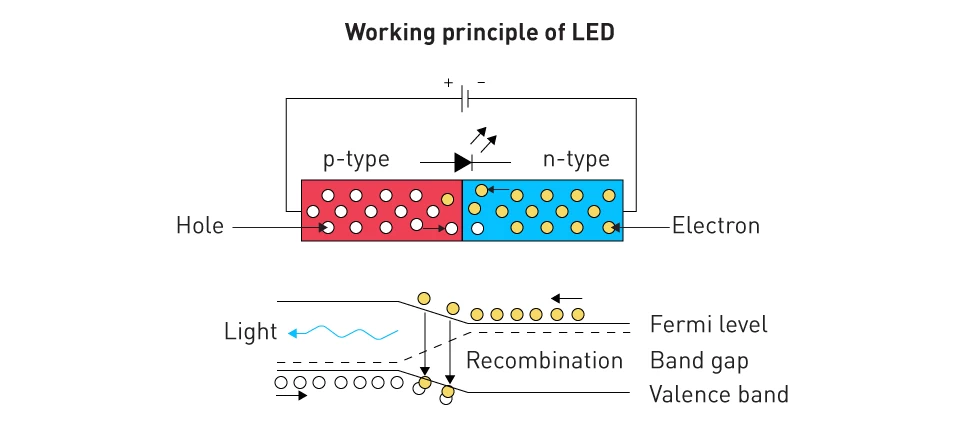
2.1 Is white the natural color of LED?
White light is the most common in our lives, so people have a misunderstanding that the natural color of LED is white.
In fact, white light is not the color naturally emitted by LED. LED can only emit monochromatic light, such as red, green, and blue. Instead, white light is formed by mixing light of other colors.
Where does the white LED light come from?
- The most commonly used is “blue light chip + yellow phosphor”.
Choose blue LED (about 450nm) and then cover it with yellow phosphor. The yellow light produced by the mixture of these two is perceived as “white light” in human eye.
This is the most common white light LED technology at present, and its advantages are stability and low cost.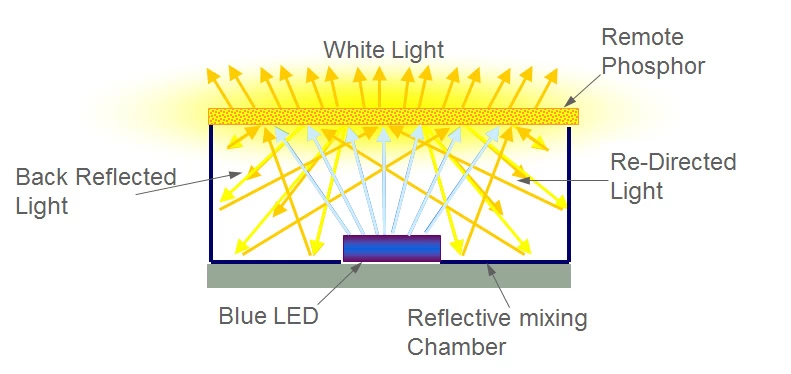
- Mixed using RGB three colors
Select red, green and blue three LEDs to emit light together, and the light after the three colors are mixed appears “white” to the human eye.
Commonly used in color-changing RGB light strips and stage lights, the color controllability is stronger, but the cost is higher.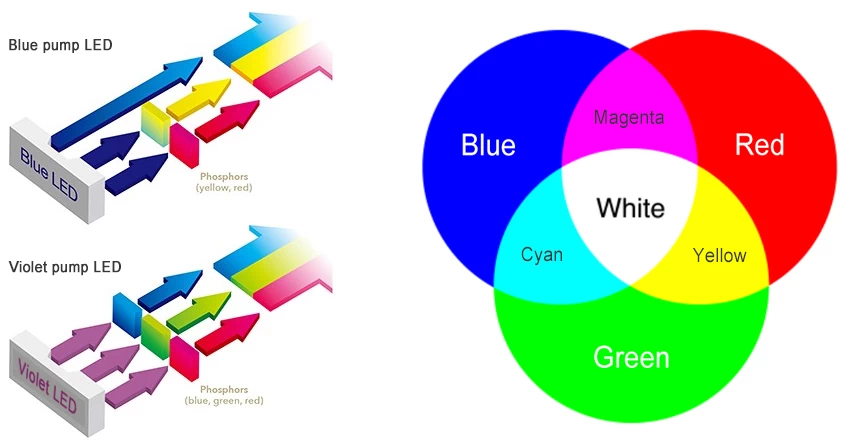
2.2 Why do we need to make LEDs in various colors?
The color diversity of LEDs is not for appearance, but to meet different scene and functional requirements. Provides functionality and atmosphere.For example :
| Color | Typical Application |
|---|---|
| Red | Emergency signals, brake lights, night-time indicators |
| Green | Power indicators, environmental lighting |
| Blue | Cool ambiance, medical devices, high-tech appearance |
| Yellow / Amber | Warning lights, traffic signals |
| UV / IR | Sterilization, remote controls, sensors |
White light with different color temperatures has different uses :
| Color Temperatures | Feel | Application |
|---|---|---|
| 2700K | Warm colors, relaxation, cozy | Bedroom, living room |
| 4000K | Neutral, natural | Office, store,road |
| 6500K | Cold colors, clarity, efficiency | Factory, workshop, stadium |
3. Common LED Lights Single Color
Monochromatic LED refers to LED that emits light of specific wavelength (color) directly from semiconductor materials. It includes red, orange, yellow, green, blue, purple, infrared LED and ultraviolet LED, etc.
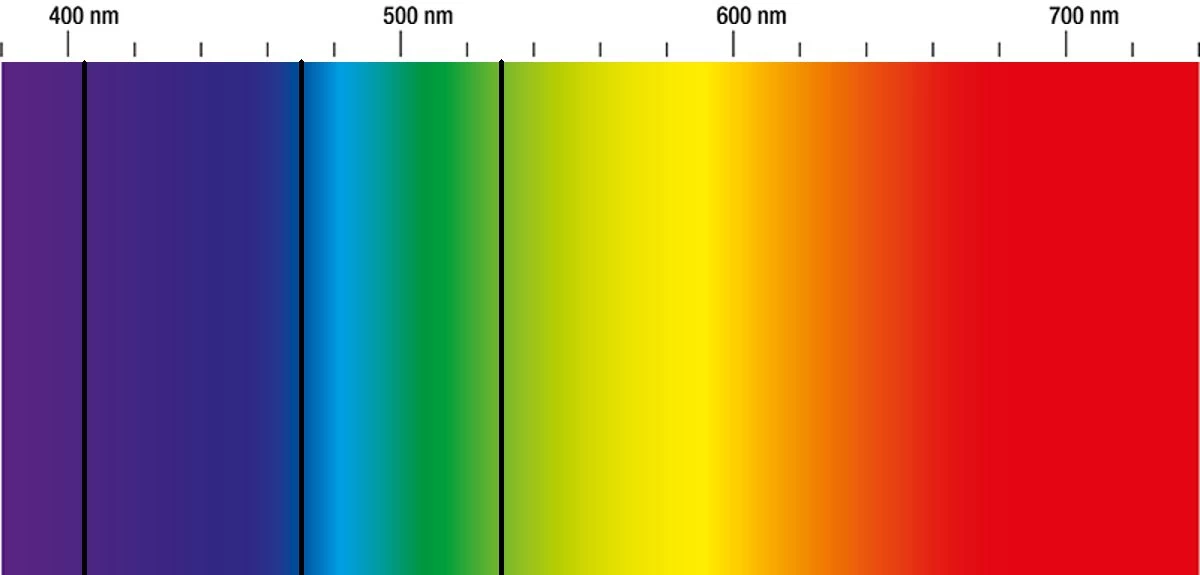
Each monochromatic LED corresponds to a specific wavelength range, and the wavelength determines each color. They vary in visual effects, characteristics and uses.
| Color | Wavelength range (nm) | Visual effect | Typical characteristics | Application |
|---|---|---|---|---|
| Red | 620 – 750 | Bright, eye-catching red | Highest efficiency, lowest cost | Indicator lights, display screens, traffic lights (stop), car tail lights/brake lights |
| Orange | 590 – 620 | Warm orange | High efficiency, low cost | Indicator lights, decorative lighting, auxiliary signals |
| Yellow | 570 – 590 | Bright, vivid yellow | Highly efficient and eye-catching | High-visibility warning lights, traffic lights (attention), car turn signals, display screens |
| Green | 495 – 570 | Emerald green to true green | There used to be a “green gap” (efficiency problem), modern high-efficiency green light is developing rapidly | Indicator lights (normal/operating), traffic lights (traffic), full-color displays, automotive backlights/ambience lights |
| Blue | 450 – 495 | Deep, vivid blue | Technology core (Nobel Prize), high efficiency, white LED foundation | White LED core, full-color display, decorative/ambience light, car daytime running light/backlight, blue light reading, plant light |
| Purple | 380 – 420 | Deep purple (close to the edge of visible light) | Low efficiency, blurred boundaries | Decoration/stage effects, excitation of fluorescent powder (pink/deep red), mosquito traps, low-power nail curing |
| Infrared | > 750 | Invisible to human eyes | Very high efficiency, sensor reception required | Remote control, night vision lighting, photoelectric sensor/light curtain, data transmission (IrDA), medical equipment (oximeter), heating |
| Ultraviolet | < 380 | Basically invisible to the human eye (UVA end is slightly purple) | High difficulty/cost, low efficiency, biological effect | UVA (315-400nm): curing (ink/glue/3D printing/nail art), banknote inspection/anti-counterfeiting, insect traps, mineral detection, black light. UVC (100-280nm): disinfection and sterilization (water/air/surface), medical phototherapy |

4. White LED And Color Temperatures
White LED lights are the most widely used and can now be seen everywhere. One particularly important attribute of white light is color temperature. The high and low color temperatures not only make a difference in color to the human eye, but also change the comfort level.
4.1 What Is LED Light Color Temperature?
The unit of color temperature is Kelvin, K. LED emits light through semiconductors, and its color temperature is the result of artificial control (such as adjusting the phosphor formula or RGB mixing ratio), the purpose of which is to simulate the light color of a “black body” at different temperatures.
The lower the value (such as 1800K) → the warmer the light color (similar to candlelight), the higher the value (such as 6500K) → the cooler the light color (similar to a cloudy sky).
4.2 Why Color Temperature Only Applies to White LEDs?
Color temperature is a dimension of variation for white light, not for monochromatic light such as red, green, blue, and purple, because they do not have a “warm and cold” contrast.
Color temperature is a color perception change of white light, not the physical wavelength of pure color light. Color LEDs do not have color temperature, only wavelength. Red light is red light, and it does not have a color temperature distribution such as “yellowish red” or “bluish red”.
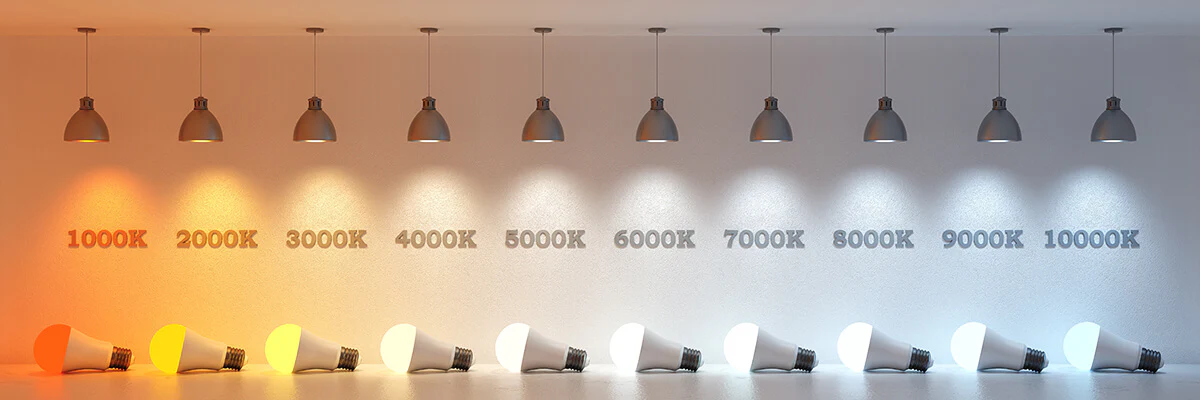
4.3 Key Considerations for Color Temperature
- Color temperature ≠ brightness
Color temperature defines the color tendency of light (yellow/white/blue), while brightness is determined by lumens (lm).
For example: a 3000K LED light may be brighter (higher lumens) than a 6000K light. - Color temperature has nothing to do with color rendering index (CRI).
Color rendering index refers to the ability of a light source to restore the true color of an object (0-100 Ra).
A high color temperature LED (such as 6500K) may also have a high color rendering index (Ra>90), and vice versa. - Blue LED ≠ high color temperature white light and yellow LED ≠ low color temperature white light.
Don’t be mistaken that high and low color temperatures of white LEDs can be used as blue and yellow LEDs. They are not related in any way.
5. How to Choose the Right LED Color
If you want to choose a color atmosphere LED light, refer to the table listed above. Pick the right LED color.
If you want to choose an LED for lighting purposes, it is a white lighting light and then choose the right color temperature.
5.1 Choose Color LED Lights
Check whether the wavelength parameters are accurate, especially infrared/ultraviolet. Check whether the light intensity is uniform to avoid color spots. Prefer brand or high stability driver chips (especially RGB modules).
| Application Scenario | Recommended Color | Reason |
|---|---|---|
| Indicator / Signal Lights | Red, Green, Yellow | High contrast, clear visibility, safety standard colors |
| Stage / Advertising / Ambience Lighting | RGB / RGBW | Adjustable colors, rich effects |
| Medical Equipment / High-Tech Ambience | Blue, White Light | Cool tone, precision lighting |
| Night Vision Assistance / Hidden Illumination | Infrared (IR) | Invisible to human eye, detectable by devices |
| Sterilization, Anti-counterfeit, Fluorescent Reaction | Ultraviolet (UV) | Excites fluorescence, damages bacterial cell structures |
5.2 Choosing Color Temperature of White LEDs
2700K/4000K/6500K are three dividing points, which are matched according to the function of the space. Low color temperature is recommended for rest areas (bedrooms/bathrooms). Medium color temperature is recommended for work areas (study rooms/offices). Medium-high or high color temperature is recommended for factories and workshops.
We are a leading manufacturer of LED lights from China, mainly engaged in white LED lighting, covering industrial and commercial series. You can browse all our products.
| Color Temperature Range | Light Color Name | Recommended Spaces | Effect Description |
|---|---|---|---|
| 1800K–2700K | Warm Yellow Light | Bedroom, Candlelight Dining Area | Simulates candlelight, promotes melatonin, aids sleep |
| 3000K–3500K | Warm White Light | Living Room, Hotel Lobby, Café | Comfortable and gentle, enhances wood/leather texture |
| 4000K–4500K | Neutral White Light | Office, Kitchen, Classroom | Crisp and fatigue-free, natural food colors |
| 5000K–6500K | Cool White Light | Operating Room, Factory, Art Gallery | High brightness, enhances metal/glass texture, cool feel |
| >6500K | Daylight White | Parking Lot, Storage Room | Intense brightness for visibility, may cause eye fatigue |
6. LED Color Conclusion
LED lights have many colors. The original LED colors are called monochrome and fixed colors. For example, red, green, blue, etc., they can be mixed into any color, called RGB color. White has a variety of color temperatures. Understanding these LED colors can help you choose the most suitable LED lighting.
7. People Also Ask
Why is LED color temperature important for white lighting?
Because color temperature directly determines the visual experience of light, the atmosphere of space, and the color rendering effect of objects.
Different environments must choose different color temperatures to achieve the best lighting experience. Choosing the wrong color temperature will destroy the design intention of the space. For example, using cold white light in the bedroom looks like an office, and using cold white light in the restaurant makes the food look pale.
Which LED color is best for sleep?
First of all, white LED with warm yellow light (1800K-2700K) is suitable for sleeping. It is soft, not dazzling, and helps to adjust the biological clock and improve sleep quality.
Secondly, red LED light is also very suitable because it contains almost no blue light components and does not interfere with melatonin secretion. Studies have shown that red light can help deep sleep or relax muscles under certain conditions. It can be used as a night light or a baby room light without irritating the retina.
Is color temperature of LED light equal to color of LED?
The color temperature of LED light is not equal to the color of LED. These are two different optical concepts.
Color temperature only describes the tendency of white light to be warm or cold (yellow → white → blue). LED color describes the hue of the light itself (red/green/blue, etc.).
People have many misunderstandings, such as:
High color temperature (6500K) white light is bluish and can be easily mistaken for “light blue light”. In fact, it still belongs to white LED light.
The “6500K blue light” advertised by merchants is a wrong statement, and the correct statement should be “6500K cold white light”.
Can any color I want be mixed by LED single color?
In theory, almost all visible colors can be achieved by mixing single-color LEDs(red、green、blue), but there are some limitations.
For example, high-saturation, high-purity colors may require 4 or 5-color LEDs to mix successfully.

